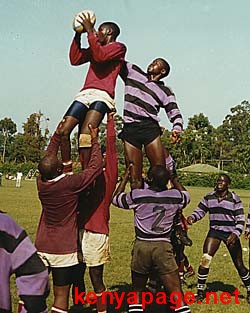THE MARKET
K
|
enya’s Fast Moving Consumer
Goods (FMCG)
market is one of the major
drivers of the country’s
economy. It also happens to be
one of the most
volatile and competitive
sectors.
As more consumers become
conscious of
what they consume, the demand
for quality brands
they can trust and identify with
has increased.
KIMBO, the white cooking fat
made from pure
refined palm oil, is one brand
that strives to meet
consumers’ needs for high
quality and a heritage
they can trust.
The brand has grown over the
years, enjoying
the number one spot in the East
African market.
Being the original white cooking
fat with a long
and successful history, KIMBO is
a Kenyan
national icon in its sector.
The growth of supermarkets and
grocery
stores in the country has seen
the brand’s
turnover increase significantly.
The typical
KIMBO consumer is a person with
a deep sense
of national pride who is very
positive about the
future and knows that family
values, culture and
traditions must be passed on.
She is a discerning woman aged
between
29 - 40 , with two to three
children. She is educated,
probably holding a managerial
position at work,
and has a disposable income. She
has had success
in life, and strongly believes
in traditional family
values. This target consumer
falls in the ABC1
group socio-economic category
and she wants a
brand that she can relate to
without being seen as
dull and not “with it”.
The KIMBO consumer wants every
member
of her family to be strong and
healthy. KIMBO’s
primary target market is women
who are seen as
leaders. They value quality and
don’t mind paying
a little extra to get a good and
trusted product.
They are strong on family values
and believe in
brands that their mothers used.
The secondary
target market is women who
aspire to get ahead
in life, who will buy the brand
when they have
the extra money.
KIMBO offers a distinctive brand
choice
based on the heritage and values
that are
embodied in the brand - one that
reflects the
consumer’s personality and
status. The brand has
been - and will continue to be -
a part of peoples
lives because it reminds them of
the rich heritage
of Kenya
they are proud of. KIMBO is the
heart of every
meal.
ACHIEVEMENTS
Until the
mid-eighties, KIMBO enjoyed almost
100 percent market
share in East Africa , as it was
environmental
management systems in place.
This means both
consumers and export markets
can trust the
standards and consistency of
KIMBO.
HISTORY
KIMBO’s history dates back many
years, when the
then EAI - incorporated in Kenya
later became Unilever - was still
operational.
BIDCO acquired the brand from
Unilever in
January 2002. The name KIMBO
comes from the
acronym Kenya Industrial
Management Board.
The brand enjoyed market monopoly
between
the 1940’s and 1980’s. The 1990’s
saw the entry of
new players like BIDCO who
brought in quality
with a price advantage.
The brand has evolved from tin
packaging
in the late 1970’s to the current
attractive plastic
tubs. In 2004, KIMBO was the
first brand to be
packaged in full colour shrink
sleeves, to keep
the brand in sync with consumer
needs.
After BIDCO took over the brand,
the texture
of the product was upgraded to
suit consumer
preference: KIMBO went from a
hard textured
fat to a soft, smooth
shortening-type cooking
fat.
THE PRODUCT
KIMBO is a white
cooking fat (or shortening)
made from pure
vegetable oils such as refined palm
oils and their
derivatives. It is also fortified with
vitamins A and D,
while its vitamin E content comes
naturally in palm
oil. Other intrinsic properties
include a bland,
neutral taste without any flavour,
that does not interfere
with the natural taste of the
food. Being vegetable
based, it is also cholesterol
free, an attribute
most enlightened consumers are
looking for in their
products today.
Kimbo white cooking
fat is available in
various stock keeping
units (SKU) of 50g sachets,
100g packets and
tubs, 250g tubs, 500g tubs, 1kg
tubs, 2kg tubs and
4kg tubs. SKU expansion has
been happening over
the years, the latest being
the introduction of
the 4kg tub in June 2002 and
the 250g tub in
August 2004.
Since BIDCO anticipates
changes in
consumer desires and
needs, the brand has been
introduced in sachets
and packets to enable the
consumers at the
bottom of the pyramid to buy a
healthy, quality
product in a size they can afford.
KIMBO is available in
shops, supermarkets,
wholesale and retail
outlets countrywide. The
brand aspires to be
the only cooking fat consumer’s
think of when they
want to cook, which is why its
slogan is: “The heart
of every meal”.
the only locally
manufactured cooking fat.
KIMBO has received several
awards and
accolades for
quality, innovation and service. The
most recent of these
is a fortification certificate
for containing
vitamin A, an essential vitamin for
people living in
developing nations - especially
children to - prevent
eyesight deficiencies.
BIDCO Oil Refineries
Ltd., the manufacturer
of KIMBO, is an ISO
9001 and ISO 14001
certified company
with world-class quality and
Kimbo.
RECENT DEVELOPMENTS
BIDCO recently signed an
agreement with the
of palm on Kalangala Island
hectares of palm have been
planted, as a result
BIDCO Uganda will have a steady
local supply
of crude palm oil which will
reduce imports to a
large degree.
In October 2004, BIDCO launched
a new
campaign aimed at revitalizing
the brand. The
campaign featured a series of
advertisements that
showcased the different values
instilled in the
brand and positioned KIMBO as
being at “The
heart of every meal.” This was
in line with the
strategy to maintain number one
market share in
The advertising campaign has
continued to
evolve over the years, from
“Pika kwa KIMBO”
(in the 1980s); “Huleta jamii
yote nyumbani”
(1990s campaign); “We build
champions” (in
2003) to “The heart of every
meal” (from 2005
to date).
PROMOTION
Over the last few
years, KIMBO has enjoyed
a continuous
advertising presence in print and
electronic media,
including local vernacular
stations. Other media
includes billboards, vehicle
branding and street
lighting.
Below-the-line
promotions include road
shows, in-store
storming, retail selling promotions
and house-to-house
storming activities. These
initiatives are
supported heavily by POS posters,
danglers, wobblers
and dividers.
KIMBO has run several
national promotional
events annually,
including the popular “Gold
rush promotion”,
“KIMBO display & win
competition”,
“Ushindi Pekee Scratch & Win
competition” and
“Vumbua Hazina” promotions.
Other promotions and
offers are run during
special periods and
festive seasons like Easter,
Ramadan, Back to
School, Mother’s day and
St. Valentine’s Day.
There are also mid-month
and end-month
supermarket offers centered on
special family
moments.
The promotions are
both trade and consumer
driven and have been
very successful.
KIMBO also sponsors
family television
programs,
underpinning what the brand stands
for. The main prizes
available to competition
entrants are also
family related items like fridges,
blenders, toasters and
other valuable appliances.
Most KIMBO adverts
revolve around heritage,
Kenyan ownership and
family values. These
include the “KIMBO
Culinary Competition”,
“My Mom cooks better
than yours”, “Truly
Kenyan” and “The
heart of every meal.”
BRAND VALUES
KIMBO brand values can be summarised as: purity
quality, value, innovation and aspirational.
The brand’s promise is to be at centre stage of
every delicious meal in a way that that no other
cooking fat can achieve - KIMBO “stirs” every
taste bud in a meaningful way.
The brand’s logo has been consistent
throughout, which has assured consumers over
time of its quality and standpoint. There are also
various vegetables on the pack, to strengthen
what the brand stands for: vegetable based purity
and healthy living.
KIMBO can be described as a leader: confident
yet approachable, desirable, sophisticated and
respectable - and of high integrity. It is identified
by four main colours - white, blue, red and
green. White symbolizes purity and clarity; Blue
symbolises truth and authority; red - confidence,
courage and vitality; and green - life, nature and
wellbeing.
KIMBO’s personality is:
• Relevant
• In touch
• Emotional
• Confident
• Energetic
• Very positive
Just as Kenyans are proud to be Kenyan,
KIMBO consumers are proud to use a quality
product their mothers used before them, and their
children will use in years to come.
THINGS YOU DIDN’T KNOW ABOUT
|
|
KIMBO
|
|
1.
KIMBO is totally
vegetable oil based and
|
|
contains no animal fats or oils
|
|
2.
KIMBO is the first
white cooking fat to
|
|
be awarded a fortification
certificate in
|
|
3.
KIMBO has become a
generic name for
|
|
.
|
|
4.
KIMBO colours resemble
the Kenyan
|
|
flag, which is why consumers
associate
|
|
the brand with “Kenyan-ness”
|





















































